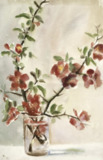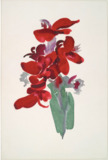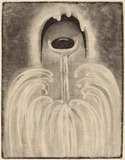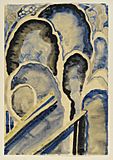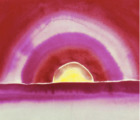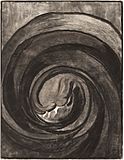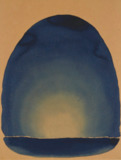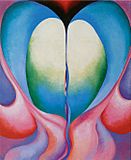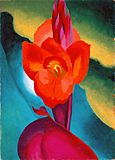Georgia O'Keeffe facts for kids
Quick facts for kids
Georgia O'Keeffe
|
|
|---|---|
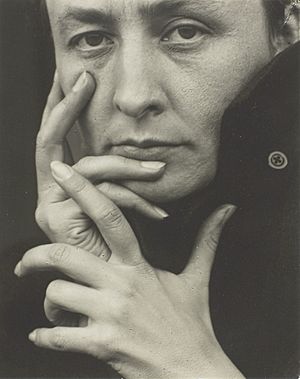
O'Keeffe in 1918, photograph by Alfred Stieglitz
|
|
| Born |
Georgia Totto O'Keeffe
November 15, 1887 Sun Prairie, Wisconsin, U.S.
|
| Died | March 6, 1986 (aged 98) Santa Fe, New Mexico, U.S.
|
| Education | School of the Art Institute of Chicago Columbia College Teachers College, Columbia University University of Virginia Art Students League of New York |
| Known for | Painting |
| Movement | American modernism, Precisionism |
| Spouse(s) | |
| Awards | National Medal of Arts (1985) Presidential Medal of Freedom (1977) Edward MacDowell Medal (1972) |
Georgia O'Keeffe (born November 15, 1887 – died March 6, 1986) was a very famous American artist. She is known for her amazing paintings, especially her close-up pictures of flowers. She also painted tall New York City buildings and the beautiful landscapes of New Mexico. Her art is special and has inspired many people for a long time.
In 2014, O'Keeffe's painting White Flower No. 1 sold for $44,405,000. At that time, it was the highest price ever paid for a painting by a female artist.
Contents
Early Life & Art Beginnings (1887-1916)
Georgia O'Keeffe was born on November 15, 1887. She grew up on a farm in Sun Prairie, Wisconsin. She was one of seven children. Her family moved several times, and she lived in Virginia before going to art school. She studied art in Chicago and New York City.
Learning to Paint & Find Her Style
From 1905 to 1908, Georgia went to art schools like the Art Institute of Chicago. These schools helped her learn important skills. But she also learned a lot by trying new things on her own. She loved exploring different art styles. She always wanted to find her own special way to express herself through painting.
In 1912, she took a summer art course. After that, she taught art in Texas and South Carolina. Teaching helped her think deeply about art. It also gave her a chance to share her passion with others. During this time, she kept working on her own unique art style.
Meeting Alfred Stieglitz
A very important event in her early career was meeting Alfred Stieglitz. He was a famous photographer and owned an art gallery in New York City. He saw Georgia's artwork and was very impressed. He started showing her paintings in his gallery, called 291. This was a huge step for her. It helped her get the recognition she deserved around 1916.
New York City & Abstract Art (1916-1929)
Many of Georgia's early paintings were abstract. This means they didn't show real things exactly as they look. Instead, she used shapes and colors to show feelings and ideas. These paintings were quite new and different. They made people talk and wonder about art. Imagine painting a flower not exactly like a real one, but using shapes and colors to suggest it in a creative way.
Exploring New Art Ideas
During this time, she used charcoal drawings and abstract paintings. She tried many different ways of painting. She always pushed the limits of what art could be. She was a pioneer, meaning she explored new ways to express herself. She also loved looking at things from different angles.
Marriage to Alfred Stieglitz
Her relationship with Alfred Stieglitz became very important. They fell in love and married in 1924. He continued to support her art and help her grow as an artist. They both influenced each other's work. They worked together and supported each other's artistic journeys.
New Mexico & Landscape Painting (1929-1986)
In 1929, Georgia started spending more time in New Mexico. She loved the desert's beauty, its unique colors, and its wide-open spaces. This time changed her art style a lot. She began painting the landscapes of New Mexico. She focused on animal bones, the vast desert, and the special beauty of the American Southwest.
Living in the Desert
In 1945, she bought a house in Abiquiú, New Mexico. She lived there for the rest of her life. She kept painting the landscapes around her. She captured the true feeling of the desert in her art. She painted mountains, skies, and flowers. But she always did it in her own special way. She didn't just copy what she saw. She showed her own feelings and understanding of the land.
Famous Flower Paintings
She painted many kinds of flowers. But she is most famous for her close-up paintings of flowers. These paintings are very detailed. They show the beauty of flowers in a way no one had seen before. She made the flowers look almost magical. She showed their textures and colors up close.
Her New Mexico landscape paintings are also very well known. She captured the desert's beauty and mystery. She showed its vastness and unique character. She used bold colors and simple shapes. This created powerful images that showed a sense of place and time.
Later Life & Lasting Legacy (1960-1986)
Even when she was older, Georgia O'Keeffe kept painting. She stayed active and creative. She made art almost until she died. She was an amazing woman who lived a long life dedicated to her art.
Awards & Recognition
She received many awards and honors during her life. These recognized her important contributions to the art world. Her work is still studied and admired today. She continues to inspire artists and art lovers everywhere. Her paintings are in many museums. They are worth a lot of money.
Georgia O'Keeffe died in Santa Fe, New Mexico, on March 6, 1986. She was 98 years old. She left behind many artworks that still amaze people. Her art shows her talent, her vision, and her dedication. She showed the world that art can be bold, beautiful, and very personal. She also showed that a woman could be a successful and important artist. She opened doors for many other women artists. Her life and work inspire many. She is remembered as one of the most important American artists of the 20th century. Her impact on art is clear. Her paintings are still celebrated for their beauty and power. She is a true icon of American art.
Awards and Honors
In 1938, O'Keeffe received an honorary degree from The College of William & Mary. Later, she was chosen to be part of the American Academy of Arts and Letters. In 1966, she became a Fellow of the American Academy of Arts and Sciences. She also received the M. Carey Thomas Award in 1971. Two years later, she received another honorary degree from Harvard University.
In 1977, President Gerald Ford gave O'Keeffe the Presidential Medal of Freedom. This is the highest honor given to American civilians. In 1985, President Ronald Reagan gave her the National Medal of Arts. In 1993, she was added to the National Women's Hall of Fame.
Personal Life
Georgia O'Keeffe and Alfred Stieglitz married in 1924. They lived mostly in New York City. But they spent their summers at his family's home in Lake George, New York. Their relationship was a strong partnership. They supported each other's artistic goals throughout their lives.
Georgia O'Keeffe Quotes
- "I found I could say things with color and shapes that I couldn't say any other way - things I had no words for."
- "Filling a space in a beautiful way - that is what art means to me."
- "I've been absolutely terrified every moment of my life - and I've never let it keep me from doing a single thing I wanted to do."
- "Whether you succeed or not is irrelevant, there is no such thing. Making your unknown known is the important thing."
Paintings
-
O'Keeffe, Drawing No. 2 – Special, 1915, charcoal on laid paper, 23.6 by 18.2 inches (60 cm × 46.3 cm), National Gallery of Art
-
O'Keeffe, No. 8 – Special, 1916, Whitney Museum of Art
-
O'Keeffe, Light Coming on the Plains No. II, 1917, watercolor on newsprint paper, 11+7⁄8 by 8+7⁄8 inches (30 cm × 23 cm), Amon Carter Museum of American Art
-
O'Keeffe, Red Canna, 1919, oil on board, High Museum of Art, Atlanta
-
O'Keeffe, A Storm, 1922, pastel on paper, mounted on illustration board, 18.3 by 24.4 inches (46.4 cm × 61.9 cm) Metropolitan Museum of Art
See also
 In Spanish: Georgia O'Keeffe para niños
In Spanish: Georgia O'Keeffe para niños



